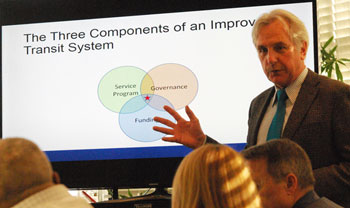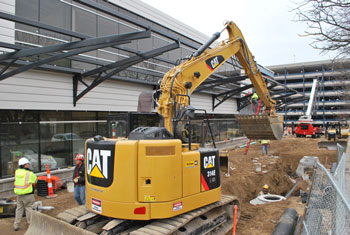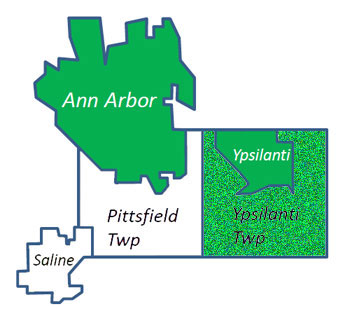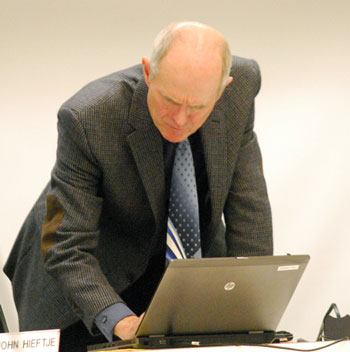Editor’s note: This “Live Updates” coverage of the Ann Arbor city council’s Nov. 18, 2013 meeting includes all the material from an earlier preview article. We think that will facilitate easier navigation from live-update material to background material already in the file.
The Nov. 18, 2013 meeting of the Ann Arbor city council is the first one with the new post-election composition of the 11-member council. The one new member of the council is Jack Eaton (Ward 4), who prevailed in the August Democratic primary contested with Marcia Higgins. She concluded 14 years of council service at her final meeting on Nov. 7.

The sign on the door to the Ann Arbor city council chamber, installed in the summer of 2013, includes Braille.
The Nov. 18 meeting will include ceremonial swearing in of all councilmembers who won election on Nov. 5 – including Eaton, Sabra Briere (Ward 1), Jane Lumm (Ward 2), Stephen Kunselman (Ward 3) and Mike Anglin (Ward 5).
Three other items internal to the council organizational configuration appear on the agenda: approval of the 2014 city council rules; appointment of the 2014 city council committees; and election of mayor pro tem, as well as establishing the order of succession for acting mayor.
In recent years, the rules and the committee appointments have been put off until the first meeting in December, with only the election of mayor pro tem taking place at the second meeting in November. Higgins had served as mayor pro tem since 2008.
Speculation among some council sources indicate that Lumm could have sufficient support on the council to win election as mayor pro tem. Mayor pro tem fulfills the duties of mayor when the mayor is out of town or unable to perform those duties. The mayor pro tem’s salary is the same as other councilmembers, which is $15,913. Customarily, the order of mayoral succession has followed seniority on the council, with councilmembers who were elected in the same year sorted alphabetically.
A substantial portion of the council’s Nov. 18 agenda consists of items the council has seen at least once before – some through postponement and others by the nature of the standard approval process. In the standard-process category, the council will be asked to confirm a handful of appointments to boards and commissions that were nominated on Nov. 7.
The council will also consider giving final approval to two ordinance revisions that received initial approval at the council’s Nov. 7 meeting. One of those ordinance revisions involves changing the permitting requirements for use of public parks – so that fees would be waived for organizations that use parks to distribute goods to meet basic human needs.
A second ordinance revision that will be up for final approval on Nov. 18 is a change to the ordinance regulating the Ann Arbor Downtown Development Authority’s tax increment finance capture and board governance.
Although it’s not yet on the online agenda, the council would expect to see a sales agreement for the former Y lot presented for consideration. The council had directed the city administrator to negotiate with Dennis Dahlmann for the sale of the land, based on his $5.25 million offer, and to present a sales agreement for approval on Nov. 18. [See 4:17 p.m. update below]
Several items on the Nov. 18 agenda were postponed from previous meetings. One of those was first seen on Nov. 7 – a resolution sponsored by Sally Petersen (Ward 2), which would direct an educational effort for local officials and the public on conflict of interest and ethics issues.
Several other items postponed from previous meetings are tied together by a transportation theme. The city council will be considering for a second time a revision to the articles of incorporation of the Ann Arbor Area Transportation Authority to admit Ypsilanti Township as a member and to increase the board membership from 9 to 10 members so that the township can appoint a member.
Postponed at the Nov. 7 meeting was the adoption of an update to the city’s non-motorized transportation plan, so the council will have a second look at that plan on Nov. 18.
Also postponed at the Nov. 7 meeting was a resolution to establish a pedestrian safety task force. It’s unclear if that task force will have sufficient traction to be appointed – because it was postponed amid concerns about the budget needed to support the task force’s work. The task force sponsors, Chuck Warpehoski (Ward 5) and Sabra Briere (Ward 1), have indicated their intent is not to make the task force an alternative to repealing the city’s mid-block crosswalk ordinance. [See 3:45 p.m. update below]
The repeal of language in the crosswalk ordinance will get its first reading at the council’s Nov. 18 meeting. The ordinance could be altered so that slowing (not necessarily stopping) would be a legal way to yield to pedestrians within crosswalks. The ordinance would be further changed so that only pedestrians within crosswalks (not those standing at the curb) would need to be accommodated by motorists.
Also related to streets are two resolutions authorizing the closing of streets in connection with New Year’s celebrations – on New Year’s Eve for the Puck Drops Here in downtown Ann Arbor, and on New Year’s Day for the NHL’s Winter Classic hockey game at Michigan Stadium.
The agenda features a few separate resolutions on standard easements and some rezoning requests. One of those rezoning requests is not standard – and was recommended by the planning commission for denial. That’s a request for rezoning a parcel on Packard Road from single-family to two-family.
The council will also be asked to authorize the city’s participation in the Michigan Economic Development Corporation’s Redevelopment Ready Communities Certification Program.
This article includes a more detailed preview of many of these agenda items. More details on other meeting agenda items are available on the city’s online Legistar system. Readers can also follow the live meeting proceedings Monday evening on Channel 16, streamed online by Community Television Network.
The Chronicle will be filing live updates from city council chambers during the meeting, published in this article below the preview material. Click here to skip the preview section and go directly to the live updates. The meeting is scheduled to start at 7 p.m. [Full Story]

















